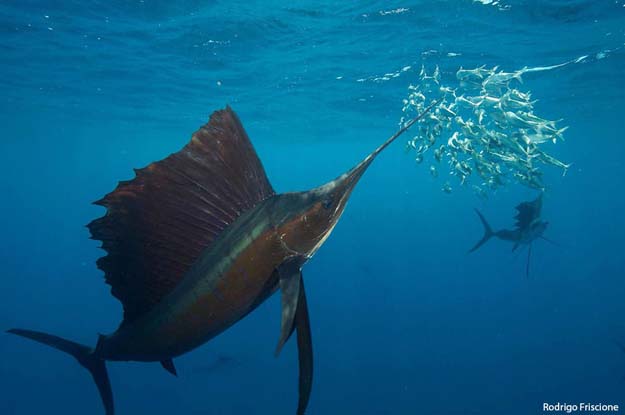[dropcap]F[/dropcap]rom the mid-1980’s to about the early 1990s, I owned three Sage RPLs that were bought at different stages of their run. The 10-weight was my favorite. It had collected king salmon in Alaska, Atlantic salmon in Iceland, peacocks in the Orinoco River tributaries, tarpon by the score in Costa Rica, lost a sailfish in Panama and itself on a flight from Miami to Belize. The other two got relieved of my abusive ownership by garage break-in theft in Ketchum, Idaho.
The ten was the best big animal fly rod I ever owned. I wish they still made it. It could turn and lift a building
The Panama sail was around 100-pounds, according to Alejandro our barely English speaking captain/guide while fishing Pinas Bay for a week in 1987. I had tied a foam slob fly (not the name but a reference to the sloppy tie) with white feathers – I cannot recall the hook size. I wasn’t fishing it for any designed purpose – just “surfing” what would interest it.
Eddie and I chummed the sail up, without intent, using crippled bonito we had easily harvested on a fly – maybe a dozen in 20 minutes… give or take.
The sail followed and then lost interest in the fly. After casting a half dozen times and just letting the fly sit in the vicinity of the bonito. Why did it refuse? All that attention and no bite? Alejandro had been screeching tirón, tirón, tirón – with reception finally coming when he used the charade of pulling. OK, a new try. Él ha enganchado!
The sail took off, running at what seemed to be Indy 500 speed, leaping along the way with its entire body out of the water. The sun angle was perfect, the fish not 30-yards away, the colors from another planetary system – spectacular. How many leaps? And then, off.
My hands were a bloody mess. They were my drag, the old Pflueger reel of no use. It should have been sent to a rest home years ago.
For the last day, I was bandaged but in the game. No sailfish, but a couple of roosters in the 20-pound class, another speed merchant – sore hand issues included.
So, what do the National Oceanic and Atmospheric Administration’s National Ocean Service say is the fastest fish in the ocean?

Sailfish hunting sardines in the open ocean off the coast of Mexico. Image courtesy of Rodrigo Friscione. IGFA World Rrecord on a fly: Pacific at 136 lbs 0 Oz on 12-pound test, and Atlantic at 102 lbs 0 Oz on 20-pound test.
That would be a fish clocked at speeds up to 70 mph – some experts consider the sailfish (Istiophorus platytypterus – Altantic and Pacific) the fastest fish in the ocean. Easily recognized, sailfish are named for the spectacular sail-like dorsal fin that extends for nearly the entire length of their silver-blue body. Additionally, the sailfish’s upper jaw is far longer than its lower jaw, forming a distinctive bill that looks like – and sometimes acts like a spear.
Often working together in groups of two or more, swift sailfish thrash at and disrupt schools of smaller fish such as sardines and anchovies, thus allowing each sailfish to more easily snag its meals. The sailfish’s spear-like bill also comes in handy for slashing at larger prey fish, which stuns them into submission. Together, sailfish engage their huge dorsal fins, creating a fence around their prey to prevent their victims from escaping their clutches.

Capt. Joe Kononchik, master fly tyer, holding billfish “Filet Mignon’s.” For years, Joe tied all of Capt. George Sawley’s billfish flies. Photo Clement.
Sailfish are a type of billfish, which also includes marlins, swordfish, and roundscale spearfish. Billfish are pelagic and prefer the warmer waters of the Atlantic and Pacific. They are often found in groups, feeding on smaller fish, crustaceans, and cephalopods (octopus, squid, and cuttlefish).
Though popular with sports anglers, sailfish cannot be taken commercially in U.S. waters except as incidental catch in Pacific longline and gillnet fisheries. Possession of sailfish is prohibited on commercial fishing vessels in the Atlantic.
NOTE: Featured Image is Capt. George Sawley holding court after his presentaion “Flyfishng for Billfish” at the Annual IGFA BILLFISH EXPO. Sawley is probably the best billfish fly fishing angler in the world with many innovations to his credit: boat, fly rod, fly line, leader, outrigger, flies, rigging and techniques. Clement photo.
Sources: National Ocean Service / National Oceanic and Atmospheric Administration / Department of Commerce, International Game Fish Association.


